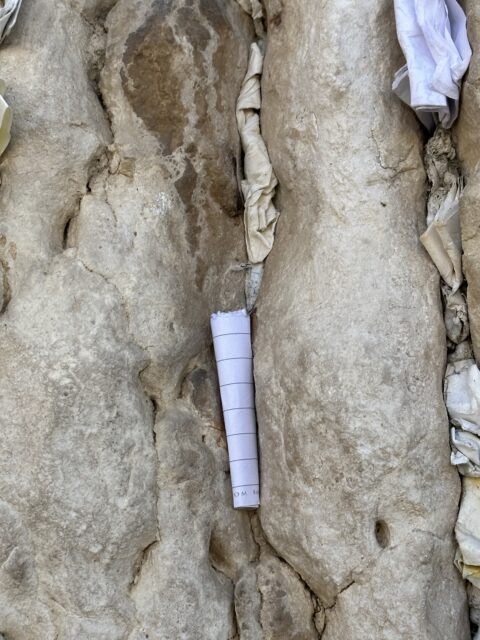(RNS) — Oh, those steps.
I am talking about the steps that lead from the Jewish Quarter in Jerusalem, down to the Western Wall plaza.
This week marks the 47th anniversary of the first time I descended those steps and then ascended them again. It was 47 years ago this week that I first came to Jerusalem to begin my studies for the rabbinate. Since then, I have made more than 50 trips to Jerusalem. Over the years, I have measured my aging by noticing the diminishing vigor with which I climb the many staircases, and hills, of this holy city. Over the years, the topographical map of Jerusalem has imprinted itself on my body — mostly my knees.
I am proud to say that due to healthy living, both the descents and ascents seem easier this summer.
Or, perhaps on this trip, my spirit is simply more buoyant. Just days before I arrived, I had retired from the active congregational rabbinate. This trip to Jerusalem is a combined study mission and retirement gift to myself.
And yet, you can take the boy out of the rabbinate (sort of), but you cannot take the rabbi out of the boy. The pastoral persona is stuck to my soul with a kind of spiritual Velcro. I can’t quit this thing. I will probably never not be a pastor; never not be someone who cares about people’s inner and outer lives.
Which means I took a bunch of stories with me in my mental backpack.
- The woman who lost her son — who had died, in the words of the poet laureate of the Jewish people, Bialik, “before his time, and before anyone’s time”
- The several friends and relatives who are dealing with illnesses and surgeries
- The grandson of a friend who is fighting cancer
- The friends who need prayers for professional and financial success
- The young couple who had just welcomed their first son
My sacred errand: go to the Western Wall (and please, not the “Wailing Wall,” which was how antisemites described the prayers of those who wept for the destruction of the ancient Temple), and say prayers for those people — in the form of the kvittel, the little note with a prayer, inserted into a crevice of that ancient structure.
(Interesting to note: In his keynote address at the Shalom Hartman Institute, Rabbi Dr. Donniel Hartman confessed that decades ago, he, too, had responded to a pastoral wish from a Jew to utter a prayer on her behalf at the Wall. So, yes — this is totally a “thing.”)
The truth is: This was not something I would have wanted to do. When it comes to the Western Wall, the “relationship is complicated.”
For several years, I had been bearing a grudge against the Western Wall (the Kotel). Over the years, a place I had once visited with a kind of sacred eagerness had become a forbidding and even discouraging place. The Western Wall had come to symbolize traditional Judaism’s negative attitudes toward women’s voices in worship. It had come to symbolize the hegemony of the Haredim in public Judaism in the Jewish State. It had become noisy, kitschified, totemic, even fetishized. On several occasions, I dissuaded families from celebrating a son’s bar mitzvah at the Kotel. I have actually come to believe the whole thing smacks of idolatry.
But, as I descended the steps and walked toward the Western Wall, I silently declared a truce in my internal war against that place.
Why? I felt a deep need to pray, and while I could and did do it in any number of synagogues in Jerusalem (and elsewhere, of course), how do I put this?
The Wall just seemed to want to listen. To hear those requests for healing and comfort and long life for those whose stories I have just related.
“Wait, Jeff: You cannot be serious. You cannot believe that the wall hears prayers!”
No, I don’t believe that. But, I must admit: Something changes within me, the pray-er, at that place.
I wanted to utter words of contrition and gratitude. I wanted to approach God and thank the Holy One of Being for granting me blessing beyond number, and beyond what I deserved. I opened my soul to God and thanked God for having blessed me with a long and decent career, with many words spoken and written, and for the ability to sustain myself in my retirement.
Do I believe God lives there? Do I believe the shechinah, the wandering indwelling feminine presence of God, dwells there? Do I believe the weeds that poke through the stones are holy? Do I believe God peers through the crevices of the wall?
Do I believe any of those things?
No.
And, yes.
Or, sometimes.
Several afternoons ago, I spent some time talking with Rabbi Yitz Greenberg, the great voice of modern Orthodoxy, at his home in Jerusalem. The experience was beyond powerful.
Some years ago, Rabbi Greenberg taught that once upon a time, people lived lives of faith that were sometimes interrupted by moments of doubt.
Today, we live lives of doubt that are sometimes interrupted by moments of faith.
I am grateful for the many times in my life that have been interrupted by moments of faith.
But not only faith. Also, the toolbox of faith — poetry, myth, imagination, ancient wanderings of the mind that have somehow crept into my own, what the sociologist Peter Berger called rumors of angels.
I hear those rumors all the time — rumors of angels, and of stones that might (might!) even be open to the deepest longings of our hearts and souls.
To you, my beloved friends and readers: Warm wishes from Jerusalem.
And, whatever your myths — may you find those moments when you believe them, as well.






